Abstract
Objective:
As in adults, hypertension is also an important risk factor for cardiovascular disease in children. We aimed to evaluate the effect of sleep duration on blood pressure in normal weight Turkish children aged between 11-17 years.
Methods:
This cross-sectional study was conducted in the primary and secondary schools of the two central and ten outlying districts of Kayseri, Turkey. Subjects were 2860 children and adolescents (1385 boys, 1475 girls). Systolic and diastolic blood pressures were measured according to the recommendations of the Fourth Report of the National High Blood Pressure Education Program Working Group on High Blood Pressure in Children and Adolescents. Sleep duration was classified as follows: ≤8 hours, 8.1-8.9 hours, 9.0-9.9 hours or ≥10 hours.
Results:
For short sleeper boys and girls (participants with a sleep duration ≤8 h) the prevalence of prehypertension and hypertension was 35.0% and 30.8%, respectively. In univariate binary logistic regression analyses (age-adjusted), each unit increment in sleep duration (hours) in boys and girls, decreased the prehypertension and hypertension risk by 0.89 [odds ratio (OR)] [confidance interval (CI); 0.82-0.98] and 0.88 (OR) (CI; 0.81-0.97), respectively (p<0.05). In multiple binary logistic regression analyses [age- and body mass index (BMI)-adjusted] the location of the school and sleep duration categories were shown to be the most important factors for prehypertension and hypertension in both genders, while household income was the most important factor, only in boys.
Conclusions:
A sleep duration ≤8 h is an independent risk factor for prehypertension and hypertension in Turkish children aged 11-17 years.
Keywords: Adolescent, blood pressure, children, sleep duration
What is already known on this topic?
Hypertension is an important risk factor for cardiovascular disease in children as well as in adults. Preventive precautions for children and adolescents should be considered in terms of maintaining a healthy lifestyle.
What this study adds?
A sleep duration ≤8 h is an independent risk factor for prehypertension and hypertension in Turkish children aged 11-17 years.
Introduction
In recent years, the prevalence of both hypertension and prehypertension are increasing worldwide (1,2,3). Increased levels of high blood pressure (BP) in childhood is an indicator for an increase in prevalence of coronary artery disease in adulthood. Sedentary lifestyle, obesity and nutritional habits are modifiable risk factors known to effect development of hypertension in childhood. The relationship between sleep duration and BP is an issue for both experimental and epidemiological studies. Both hypertension and coronary artery disease have been associated with sleep duration in adults (4,5). However, the etiology of this relationship is not fully understood. Changes in hormonal activity, increased activity of the renin-angiotensin-aldosterone system and changes in circadian rhythm have been reported to have a role in this relationship (6,7,8,9,10).
The best approach to prevent hypertension-related mortality or morbidity is to prevent and treat the hypertension (11). However the treatment of hypertension is difficult and complex. Despite major advances in treatment of hypertension in the past few decades, the majority of patients fail to achieve treatment goals. Lifestyle changes including a low salt diet, weight loss, regular physical activity, cessation of smoking and diet therapy are important in decreasing the risk of hypertension-related disease (12,13).
Much current epidemiologic research, related to lifestyle, focuses on the relationship between short sleep duration and hypertension prevalence (11,13). In the current study, we aimed to evaluate the effects of lifestyle characteristics on BP among children living in one of the biggest city in Central Anatolia, Kayseri.
Methods
This cross-sectional study was performed on a large cohort of children, aged 11-17 years. All children attended primary and secondary schools located centrally (two schools) and in the outlying districts (ten schools) of the town of Kayseri in Turkey. Kayseri is one of the largest three cities in Central Anatolia with more than 1.000.000 inhabitants. Data were obtained from the “Determination of Anthropometric Measurements of Turkish Children and Adolescents” survey (14,15).
The study was approved by the Ethics Committee of Erciyes University School of Medicine and Kayseri Province Educational Board (approval number: 04/312, approval date: 07/09/2004). Written consent was taken from the parents at the beginning of the study in accordance with the Declaration of Helsinki. Decimal age was calculated by subtracting the birth date from the observation date (16).
Anthropometric Indices
All anthropometric indices were measured twice by experienced health professionals and the mean value was recorded for analyses. All inter-observer correlation coefficients were ≥0.91.
Weight was measured using a standard beam balance sensitive to 0.1 kg, using a Tefal Ultraslim (France), in minimal clothing (bare feet and with light clothing).
Height was measured with a portable Seca stadiometer with a sensitivity of 0.1 cm. Daily calibration was made to the device. Measurements were made with the subject barefoot, the heels, hip and shoulders touching the stadiometer and the head in neutral position with eyes gazing forward.
Body mass index (BMI) was calculated by dividing body weight in kilograms by the square of body height in meters (kg/m2).
Systolic BP (SBP), and diastolic BP (DBP) were measured according to the recommendations of the Fourth Report of the National High Blood Pressure Education Program Working Group on High Blood Pressure in Children and Adolescents (15,17). According to BP charts for age, gender and height, normal, pre- and hypertension were defined as SBP and DBP below the 90th percentile, between 90th-<95th percentile and equal to or higher than 95th percentile respectively (15).
Several anthropometric indices were measured: waist circumference (WC), mid-upper arm circumference (MUAC), triceps skinfold thickness, arm fat area, MUAC fat percentage (14). WC was divided by height to yield the WC to height ratio.
Demographics
A questionnaire form constructed by the researchers with socio-demographic variables was used. Computer use (hours), sleep duration (hours), TV viewing (hours), location of residence (urban/suburban), mode of transport to school (walking or by car), self-reported household income (good, fair, poor), house size (m2), parental education, elevator use (none/habitual), maternal employment (housewife/employed) were asked (14).
The questionnaire was sent to parents and the question related to sleep was asked as, “How many hours of sleep does your child usually get?”, aiming to provide information to the researchers on the child’s habitual sleep duration. Sleep duration was classified into four groups as: ≤8 h, 8-9 h, 9-10 h, and ≥10 h and these categories were selected to compare the results of the current study with similar studies (18).
The following sociodemographic and behavioral effectors of obesity were analysed: computer use, sleep duration, viewing duration of TV, place of residence, appetite, mode of transport to school, household income, house size, parental education, maternal employment and elevator use (14).
Statistical Analysis
Chi-square tests were used to determine significant differences in proportions among categorical variables and to compare continuous variables independent sample’s t-test was used. Anthropometric indices were compared with sleep duration categories by analysis of covariance (adjustment for multiple comparisons: Bonferroni), where age or age and BMI were the covariates. Univariate (adjusted age) and multiple (the backward stepwise procedure; adjusted age or age and BMI) binary logistic regression analyses were used to examine the risk factors to influence whether SBP or DBP≥90th percentile (prehypertension and hypertension). All statistical analyses were performed by R2.14.0 program (www.r-project.org). Two-tailed p-values of <0.05 were considered to be statistically significant.
Results
The study included 2860 children. Of the sample 1385 (48.4%) were boys and 1475 (49.6%) were girls. Prehypertension and hypertension together (DBP≥90th) was found in 485/1385 (35.0%; 95% CI 0.32.5-0.37.6) of boys and 455/1475 (30.8%; 95% CI 0.28.5-0.33.3) of girls, respectively. Prehypertension prevalences in this group were 26.3% and 22.4% for boys and girls, respectively. In both genders, we found that increased sleep duration was significantly related with decreased prehypertension and hypertension (Table 1). In Table 2, the relationship between sleep duration (≤8 h, 8.1-8.9 h, 9.0-9.9 h, ≥10 h), anthropometric indicators of metabolic risk and BP is shown. The unique significant finding in this comparison was the reduction in mean SBP from 112.9 mmHg to 107.9 mmHg in girls and the reduction in mean DBP from 72.7 mmHg to 69.4 mmHg in boys as sleep duration increases.
Table 1. The relationship between sleep duration and blood pressure for boys and girls.

Table 2. The comparison of several variables by sleep duration categories in boys and girls.
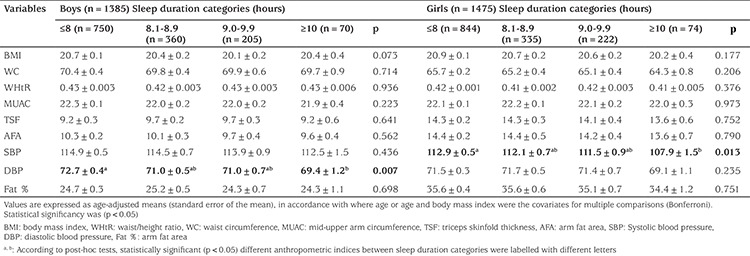
In Tables 3A and 3B, the effects of prehypertension on sociodemographic and behavioural variables for children and adolescents (by univariate and multiple binary logistic regression analyses) are shown. Increase in sleep duration and decrease in BMI are two indicators of normal BP in both genders. The corresponding odds for sleep duration were OR: 0.89, CI; 0.82-0.98 and OR: 0.88, CI; 0.81-0.97, respectively for boys and girls. The corresponding odds for BMI were OR: 1.12, CI; 1.08-1.16 and OR: 1.09, CI; 1.06-1.14 respectively for boys and girls (Table 3A).
Table 3A. Univariate and multiple binary logistic regression of the likelihood of prehypertension on sociodemographic and behavioural variables for children and adolescents [with odds ratio and 95% confidence intervals].
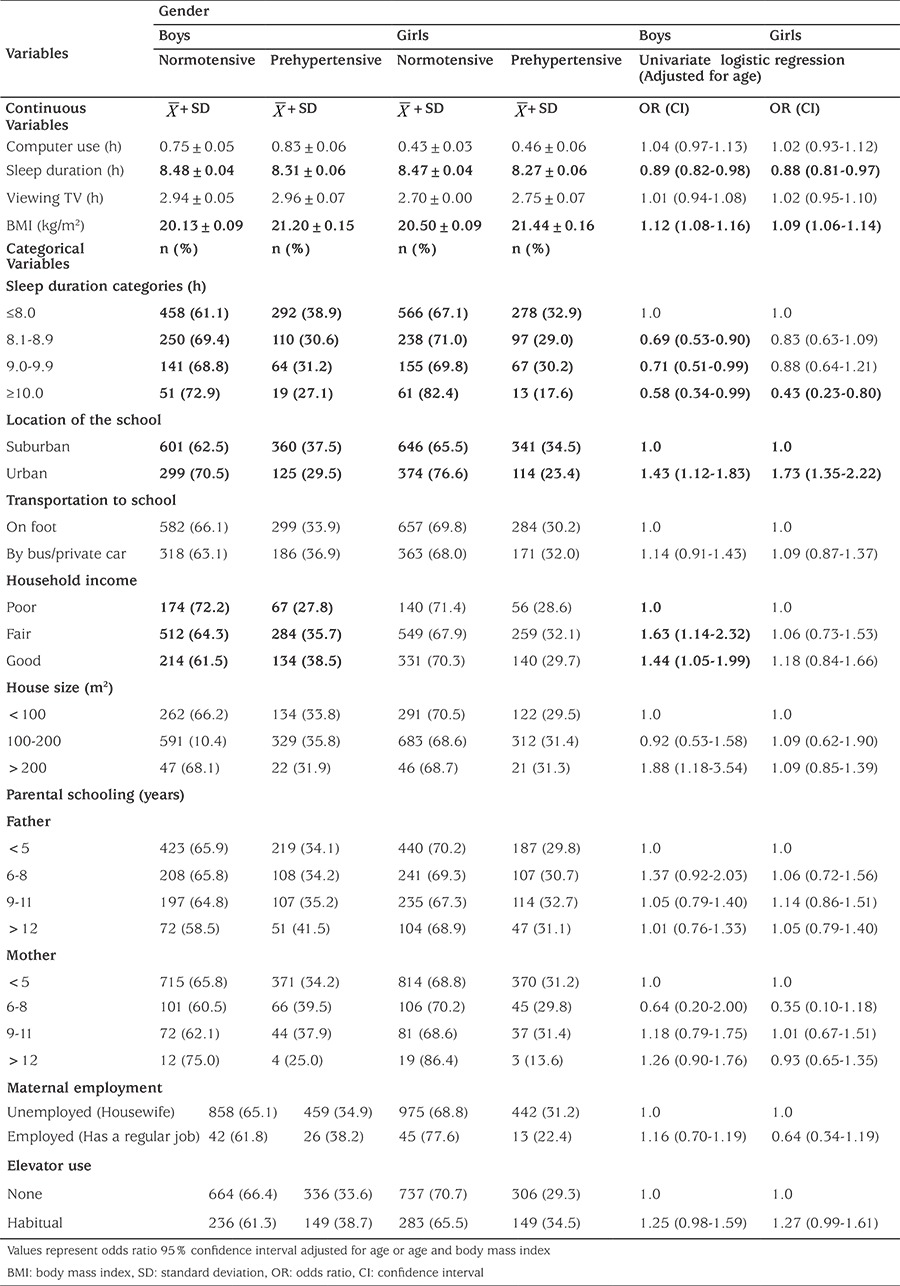
Table 3B. Multiple logistic regression analysis of the likelihood of prehypertension on sociodemographic and behavioural variables for children and adolescents.
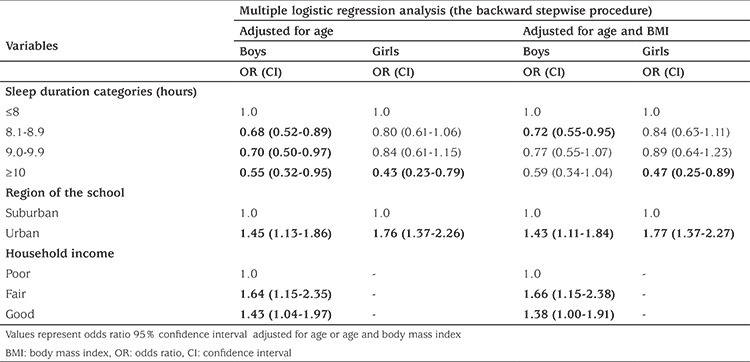
We adjusted our dependent variables (normotensive/prehypertensive and hypertensive) for BMI and age in multiple binary logistic regression. Independent variables in this categoric analysis that were statistically significant (p<0.05) were; location of the school (in both genders), sleep duration (in both genders) and household income (only in boys). There was no relationship between maternal employment, paternal education, house size, elevator use and mode of transport to school (p>0.05). Sleeping 8-9 hours compared to sleeping less than 8 hours in boys and sleeping more than 10 hours compared to sleeping less than 8 hours a day in girls were the risk factors for increased BP. Residing in urban versus rural areas was shown to be a risk factor for increased prehypertension and hypertension risk; OR: 1.43, CI: 1.11-1.84, OR: 1.77; CI; 1.37-2.27, respectively in boys and girls (Table 3B, p<0.05).
SBP and DBP values according to sleep duration are shown in Figure 1. Longer sleep duration was associated with lower BP. The distribution of sleep duration for age groups in boys and girls is given in Figure 2. In both genders, sleep duration showed a decrease with increase in age.
Figure 1. Systolic and diastolic blood pressure values according to sleep duration.
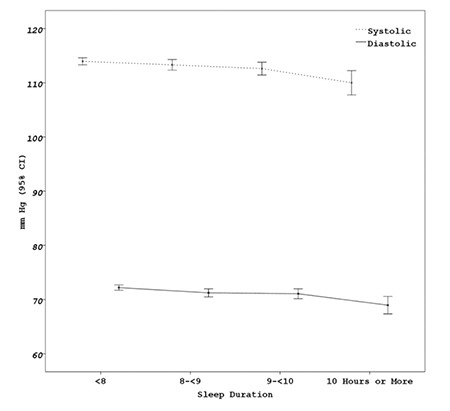
Figure 2. The distribution of sleep duration by age groups in boys and girls.
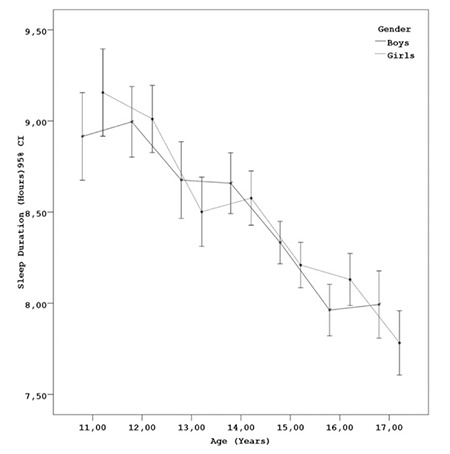
Discussion
Previous studies on adults indicate that there is a strong relationship between sleep duration and increased BP (19,20,21). To the best of our knowledge, the current study is the first to demonstrate a relationship between short sleep duration and high BP in children and adolescents aged 11-17 years. According to the univariate binary logistic regression analyses, sleep duration less than 8 h is a significant risk factor for hypertension in both genders. With each increment in sleeping hours for boys and girls, the risk of increased BP decreases (OR:0.89, CI: 0.82-0.98 and OR: 0.88, CI: 0.81-0.97 respectively in boys and girls). In multiple binary logistic regression analyses (adjusted for age and BMI) and by categorising sleep duration into four groups (≤8 h, 8.1-8.9 h, 9.0-9.9 h, ≥10 h), shorter sleep duration was also shown to be a risk factor for increased BP. There are several studies examining the relationship between increased BP and various environmental conditions, other than sleep duration (22,23,24,25,26). In this present study, the only other significant environmental risk factor identified was location of the school the children or adolescents were attending and this was only true of the girls. No other environmental risk factors included in this study were found to be an independent risk factor in our data set.
The American Academy of Sleep Medicine developed new consensus recommendations for the amount of sleep needed to promote optimal health, including avoidance of hypertension in children and adolescents. According to these recommendations, teenagers 13-to-18 years of age should sleep 8-to-10 hours per 24 hours on a regular basis to promote optimal health (27).
In a recent review on sleep characteristics and cardiovascular risk in children and adolescents, sleep pattern is indicated as a significant risk factor for cardiovascular disease, however the sleep pattern may differ between different geographic locations (28). Similarly, Meininger et al (29), demonstrated that long sleep duration is associated with a decrease both in SBP and DBP. In the study by Archbold et al (30) in 334 children aged 6-11 years, both a decrease in sleep duration and an increase in BMI were associated with increased BP. Prehypertension and hypertension were both associated with short sleep duration (less than eight hours) among Lithuanian children and adolescents (n=6940) aged 12 to 15 years; when adjusted for age, gender, BMI, physical activity and smoking (31).
However, a recent longitudinal analysis from early-to-late adolescence found no association between sleep duration and BP in females. However, in males longer sleep duration was associated with lower values of BP (32).
Our study was conducted in a large province of central Anatolia in Turkey. In other previous studies, higher salivary cortisol levels were detected in individuals with short sleep when compared with normal or high sleep duration (33). In healthy young adults, impaired vascular endothelial adhesion markers and also endothelial-dependent/independent microvascular reactivity were detected in acute total sleep deprivation (34). Additionally, decreased endothelial-dependent vasodilatation, representing impaired endothelial function, was reported in participants with short sleep duration. In another study, participants with a sleep duration of less than five hours were found to have significant changes in heart rates and BP values (35). Significant increases in catecholamine levels measured in 24-hour urine samples were reported in adults, suggesting an increase in sympathetic activity related to short sleeping hours (36).
In accordance with previous studies, we found a relationship between short sleep duration and hypertension in children and adolescents of both genders (32,33). In the current study, with the decrement in sleep duration, hypertension risk is increased. However, in previous studies, the relationship betwen short sleep duration and the risk of hypertension in adult women were explained by structural characteristics (BMI and other body composition variables) and menopause (37,38,39).
Peach et al (40), examined BMI as a possible mediator of the effect of sleep duration on risk for hypertension in a sample of sixth graders. Among boys, all three sleep characteristics (school-night sleep duration, weekend night sleep duration, and daytime sleepiness) predicted BMI and yielded significant indirect effects on risk for hypertension. In girls on the other hand, only daytime sleepiness predicted BMI and yielded a significant indirect effect on risk for hypertension.
The primary contribution of the current study may be revealing the age- and BMI-adjusted risk factors for increased BP associated with decreased sleeping duration.
Study Limitations
However, the main limitation of our study is that we did not use a validated scale to assess sleep duration and relied on self-reports of the parents for sleep duration of their children (41,42,43,44,45,46,47,48). The cross-sectional measurement of BP to assess increased BP is also a limitation of this study.
Conclusion
To the best of our knowledge, the current study is the the first to demonstrate that short sleep duration is a risk factor for increased BP in non-obese, Turkish children. We believe this issue requires further exploration.
Footnotes
Ethics
Ethics Committee Approval: The study was approved by the Erciyes University Local Ethics Committee (approval number: 04/312 approval date: 07/09/2004).
Informed Consent: Consent form was filled out by the parents of all children and adolescents.
Peer-reviewed: Externally peer-reviewed.
Authorship Contributions
Surgical and Medical Practices: Mümtaz M Mazıcıoğlu, Selim Kurtoğlu, Concept: Ahmet Öztürk, Betül Çiçek, Demet Ünalan, Dinçer Göksülük, Sevda İsmailoğulları, Selim Kurtoğlu, Design: Cengiz Bal, Ahmet Öztürk, Betül Çiçek, Vahap Eldem, Data Collection or Processing: Betül Çiçek, Ahmet Öztürk, Emine Erdem, Selim Kurtoğlu, Analysis or Interpretation: Ahmet Öztürk, Gökmen Zararsız, Gözde Ertürk Zararsız, Selçuk Korkmaz, Dinçer Göksülük, Literature Search: Ahmet Öztürk, Betül Çiçek, Gözde Ertürk Zararsız, Ahmet Özdemir, Mümtaz M Mazıcıoğlu, Writing: Betül Çiçek, Cengiz Bal, Ahmet Öztürk, Ahmet Özdemir, Sevda İsmailoğulları, Mümtaz M Mazıcıoğlu.
Financial Disclosure: The authors declared that this study received no financial support.
References
- 1.Polat M, Yıkılkan H, Aypak C, Görpelioğlu S. The relationship between BMI and blood pressure in children aged 7-12 years in Ankara, Turkey. Public Health Nutr. 2014;17:2419–2424. doi: 10.1017/S1368980014000846. [DOI] [PMC free article] [PubMed] [Google Scholar]
- 2.Moore WE, Eichner JE, Cohn EM, Thompson DM, Kobza CE, Abbott KE. Blood pressure screening of school children in a multiracial school district: the Healthy Kids Project. Am J Hypertens. 2009;22:351–356. doi: 10.1038/ajh.2009.13. [DOI] [PubMed] [Google Scholar]
- 3.Rafraf M, Gargari BP, Safaiyan A. Prevalence of prehypertension and hypertension among adolescent high school girls in Tabriz, Iran. Food Nutr Bull. 2010;31:461–465. doi: 10.1177/156482651003100308. [DOI] [PubMed] [Google Scholar]
- 4.Knutson KL, van Cauter E, Rathouz PJ, Yan LL, Hulley SB, Liu K, Lauderdale DS. Association between sleep and blood pressure in midlife: the CARDIA sleep study. Arch Intern Med. 2009;169:1055–1061. doi: 10.1001/archinternmed.2009.119. [DOI] [PMC free article] [PubMed] [Google Scholar]
- 5.King CR, Knutson KL, Rathouz PF, Sidney S, Liu K, Lauderdale DS. Short sleep duration and incident coronary artery calcification. JAMA. 2008;300:2859–2866. doi: 10.1001/jama.2008.867. [DOI] [PMC free article] [PubMed] [Google Scholar]
- 6.Spiegel K, Tasali E, Penev P, van Cauter E. Sleep curtailment in healthy young men is associated with decreased leptin levels, elevated ghrelin levels, and increased hunger and appetite. Ann Intern Med. 2004;141:846–850. doi: 10.7326/0003-4819-141-11-200412070-00008. [DOI] [PubMed] [Google Scholar]
- 7.Tochikubo O, Ikeda A, Miyajima E, Ishii M. Effects of insufficient sleep on blood pressure monitored by a new multibiomedical recorder. Hypertension. 1996;27:1318–1324. doi: 10.1161/01.hyp.27.6.1318. [DOI] [PubMed] [Google Scholar]
- 8.Lusardi P, Mugellini A, Preti P, Zoppi A, Derosa G, Fogari R. Effects of insufficient sleep on blood pressure in hypertensive patients: a 24-h study. Am J Hypertens. 1999;12:63–68. doi: 10.1016/s0895-7061(98)00200-3. [DOI] [PubMed] [Google Scholar]
- 9.Scheer FA, van Montfrans GA, van Someren EJ, Mairuhu G, Buijs RM. Daily nighttime melatonin reduces blood pressure in male patients with essential hypertension. Hypertension. 2004;43:192–197. doi: 10.1161/01.HYP.0000113293.15186.3b. [DOI] [PubMed] [Google Scholar]
- 10.Goncharuk VD, van Heerikhuize J, Dai JP, Swaab DF, Buijs RM. Neuropeptide changes in the suprachiasmatic nucleus in primary hypertension indicate functional impairment of the biological clock. J Comp Neurol. 2001;431:320–330. doi: 10.1002/1096-9861(20010312)431:3<320::aid-cne1073>3.0.co;2-2. [DOI] [PubMed] [Google Scholar]
- 11.Gottlieb DJ, Redline S, Nieto FJ, Baldwin CM, Newman AB, Resnick HE, Punjabi NM. Association of usual sleep duration with hypertension: the Sleep Heart Health Study. Sleep. 2006;29:1009–1014. doi: 10.1093/sleep/29.8.1009. [DOI] [PubMed] [Google Scholar]
- 12.Elmer PJ, Obarzanek E, Vollmer WM, Simons-Morton D, Stevens VJ, Young DR, Lin PH, Champagne C, Harsha DW, Svetkey LP, Ard J, Brantley PJ, Proschan MA, Erlinger TP, Appel LJ PREMIER Collaborative Research Group. Effects of comprehensive lifestyle modification on diet, weight, physical fitness, and blood pressure control: 18-month results of a randomized trial. Ann Intern Med. 2006;144:485–495. doi: 10.7326/0003-4819-144-7-200604040-00007. [DOI] [PubMed] [Google Scholar]
- 13.Palagini L, Bruno RM, Gemignani A, Baglioni C, Ghiadoni L, Rienann D. Sleep loss and hypertension: a systematic review. Curr Pham Des. 2013;19:1–11. doi: 10.2174/1381612811319130009. [DOI] [PubMed] [Google Scholar]
- 14.Cicek B, Ozturk A, Mazicioglu MM, Elmali F, Turp N, Kurtoglu S. The risk analysis of arm fat area in Turkish children and adolescents. Ann Hum Biol. 2009;36:28–37. doi: 10.1080/03014460802537690. [DOI] [PubMed] [Google Scholar]
- 15.Bal C, Yalçın BM, Mazıcıoğlu MM, Öztürk A, Bayat M, Üstünbaş HB, Kurtoğlu S. Blood Pressure Percentiles for the Children Between 11-17 Years of Age in Kayseri. Türkiye Klinikleri J Med Sci. 2009;29:1412–1420. [Google Scholar]
- 16.Hindmarsh PC, Brook CGD. Normal growth and its endocrine control. In: Clinical Paediatric Endocrinology. Brook CGD, ed. 3rd ed. Blackwell Science Ltd. Oxford. 1995:85–106. [Google Scholar]
- 17.National High Blood Pressure Education Working Group of High Blood pressure in Children and Adolescents. The fourth report on the diagnosis, evaluation, and treatment of high blood pressure in children and adolescents. Pediatrics. 2004;114:555–576. [PubMed] [Google Scholar]
- 18.Mazıcıoğlu MM, Bektas MY, Öztürk A, Üstünbaş HB, Kurtoğlu S. Anthropometric risk factors for elevated blood pressure in adolescents in Turkey aged 11-17. Pediatr Nephrol. 2010;25:2327–2334. doi: 10.1007/s00467-010-1623-x. [DOI] [PubMed] [Google Scholar]
- 19.Deng HB, Tam T, Zee BC, Chung RY, Su X, Jin L, Chan TC, Chang LY, Yeoh EK, Lao XQ. Short Sleep Duration Increases Metabolic Impact in Healthy Adults: A Population-Based Cohort Study. Sleep. 2017;40. doi: 10.1093/sleep/zsx130. [DOI] [PubMed] [Google Scholar]
- 20.Shivashankar R, Kondal D, Ali MK, Gupta R, Pradeepa R, Mohan V, Kadir MM, Narayan KMV, Tandon N, Prabhakaran D, Peasey A. Associations of sleep duration and Disturbances with hypertension in metropolitan Cities of Delhi, Chennai, and Karachi in South Asia: Cross-sectional analysis of the CARRS study. Sleep. 2017;40. doi: 10.1093/sleep/zsx119. [DOI] [PMC free article] [PubMed] [Google Scholar]
- 21.Im E, Kim GS. Relationship between sleep duration and Framingham cardiovascular risk score and prevalence of cardiovascular disease in Koreans. Medicine (Baltimore) 2017;96:e7744. doi: 10.1097/MD.0000000000007744. [DOI] [PMC free article] [PubMed] [Google Scholar]
- 22.Simonyte S, Kuciene R, Medzioniene J, Dulskiene V, Lesauskaite V. Renin-angiotensin system gene polymorphisms and high blood pressure in Lithuanian children and adolescents. BMC Med Genet. 2017;18:100. doi: 10.1186/s12881-017-0462-z. [DOI] [PMC free article] [PubMed] [Google Scholar]
- 23.Pardee PE, Norman GJ, Lustig RH, Preud’homme D, Schwimmer JB. Television viewing and hypertension in obese children. Am J Prev Med. 2007;33:439–443. doi: 10.1016/j.amepre.2007.07.036. [DOI] [PubMed] [Google Scholar]
- 24.DellaValle DM, Carter J, Jones M, Henshaw MH. What is the relationship between dairy intake and blood pressure in black and white children and adolescents enrolled in a weight management program. J Am Heart Assoc. 2017;6:e004593. doi: 10.1161/JAHA.116.004593. [DOI] [PMC free article] [PubMed] [Google Scholar]
- 25.Hu J, Shen H, Chu GP, Fu H, Huang FF, Zheng YM, Han D, Zhou YK, Wang Q, Wang B, Teng CG, Liu F, Yang HB. Association of elevated resting pulse rate with increased risk of hypertension development in children: A prospective study in Suzhou, China. Medicine (Baltimore) 2017;96:e7696. doi: 10.1097/MD.0000000000007696. [DOI] [PMC free article] [PubMed] [Google Scholar]
- 26.Krzywinska-Wiewiorowska M, Stawinska-Witoszynska B, Krzyzaniak A, Kaczmarek M, Siwinska A. Environmental variation in the prevalence of hypertension in children and adolescents - is blood pressure higher in children and adolescents living in rural areas? Ann Agric Environ Med. 2017;24:129–133. doi: 10.5604/12321966.1230678. [DOI] [PubMed] [Google Scholar]
- 27.Paruthi S, Brooks LJ, D’Ambrosio C, Hall WA, Kotagal S, Lloyd RM, Malow BA, Maski K, Nichols C, Quan SF, Rosen CL, Troester MM, Wise MS. Consensus Statement of the American Academy of Sleep Medicine on the Recommended Amount of Sleep for Healthy Children: Methodology and Discussion. J Clin Sleep Med. 2016;12:1549–1561. doi: 10.5664/jcsm.6288. [DOI] [PMC free article] [PubMed] [Google Scholar]
- 28.Matthews KA, Pantesco EJ. Sleep characteristics and cardiovascular risk in children and adolescents: an enumerative review. Sleep Med. 2016;18:36–49. doi: 10.1016/j.sleep.2015.06.004. [DOI] [PMC free article] [PubMed] [Google Scholar]
- 29.Meininger JC, Gallagher MR, Eissa MA, Nguyen TQ, Chan W. Sleep duration and its association with ambulatory blood pressure in a school-based, diverse sample of adolescents. Am J Hypertens. 2014;27:948–955. doi: 10.1093/ajh/hpt297. [DOI] [PMC free article] [PubMed] [Google Scholar]
- 30.Archbold KH, Vasquez MM, Goodwin JL, Quan SF. Effects of sleep patterns and obesity on increases in blood pressure in a 5-year period: Report from the Tucson Children’s Assessment of Sleep Apnea Study. J Pediatr. 2012;161:26–30. doi: 10.1016/j.jpeds.2011.12.034. [DOI] [PMC free article] [PubMed] [Google Scholar]
- 31.Kuciene R, Dulskiene V. Associations of short sleep duration with prehypertension and hypertension among Lithuanian children and adolescents: a cross-sectional study. BMC Public Health. 2014;14:255. doi: 10.1186/1471-2458-14-255. [DOI] [PMC free article] [PubMed] [Google Scholar]
- 32.Paciência I, Araújo J, Ramos E. Sleep duration and blood pressure: A longitudinal analysis from early to late adolescence. J Sleep Res. 2016;25:702–708. doi: 10.1111/jsr.12433. [DOI] [PubMed] [Google Scholar]
- 33.Räikkönen K, Matthews KA, Pesonen AK, Rikka P, Juulia PE, Kimmo F, Alexander J, David IWP, Jonathan RS, Kati H, Niina JK, Anna-Liisa J, Johan GE, Timo ES, Eero K. Poor sleep and altered hypothalamic-pituitary- adrenocortical and sympathoadrenal-medullary system activity in children. J Clin Endocrinol Metab. 2010;95:2254–2261. doi: 10.1210/jc.2009-0943. [DOI] [PubMed] [Google Scholar]
- 34.Sauvet F, Leftheriotis G, Gomez-Merino D, Lanqrume C, Drogou C, van Beers P, Bourrilhon C, Florence G, Chennaoui M. Effect of acute sleep deprivation on vascular function in healthy subjects. J Appl Physiol (1985) 2010;108:68–75. doi: 10.1152/japplphysiol.00851.2009. [DOI] [PubMed] [Google Scholar]
- 35.Dettoni JL, Consolim-Colombo FM, Drager LF, Rubiram C, Souza SB, Irigoyen MC, Mostarda C, Borile S, Krieger EM, Moreno H Jr, Lorenzi-Filho G. Cardiovascular effects of partial sleep deprivation in healthy volunteers. J Appl Physiol (1985) 2012;113:232–236. doi: 10.1152/japplphysiol.01604.2011. [DOI] [PubMed] [Google Scholar]
- 36.Zhang J, Ma RC, Kong AP, So WY, Li MA, Lam SP, Li SX, Yu MW, Ho CS, Chan MH, Zhang B, Wing YK. Relationship of sleep quantity and quality with 24-hour urinary catecholamines and salivary awakening cortisol in healthy middle-aged adults. Sleep. 2011;34:225–233. doi: 10.1093/sleep/34.2.225. [DOI] [PMC free article] [PubMed] [Google Scholar]
- 37.Kawabe H, Saito I. Does short sleep duration in daily life affect morning home blood pressure? Evaluation in Japanese people. Clin Exp Hypertens. 2008;30:183–190. doi: 10.1080/10641960802064575. [DOI] [PubMed] [Google Scholar]
- 38.St-Onge MP, Perumean-Chaney S, Desmond R, Cora EL, Lewis CE, Yan LL, Person SD, Allison DB. Gender differences in the association between sleep duration and body composition: The Cardia Study. Int J Endocrinol. 2010;2010:726071. doi: 10.1155/2010/726071. [DOI] [PMC free article] [PubMed] [Google Scholar]
- 39.Cappuccio FP, Stranges S, Kandala NB, Miller MA, Taggart FM, Kumari M, Ferrie JE, Shipley MJ, Brunner EJ, Marmot MG. Gender-specific associations of short sleep duration with prevalent and incident hypertension: the Whitehall II Study. Hypertension. 2007;50:693–700. doi: 10.1161/HYPERTENSIONAHA.107.095471. [DOI] [PMC free article] [PubMed] [Google Scholar]
- 40.Peach H, Gaultney JF, Reeve CL. Sleep characteristics, body mass index, and risk for hypertension in young adolescents. J Youth Adolesc. 2015;44:271–284. doi: 10.1007/s10964-014-0149-0. [DOI] [PubMed] [Google Scholar]
- 41.Bayer O, Neuhauser H, von Kries R. Sleep duration and blood pressure in children: a cross-sectional study. J Hypertens. 2009;27:1789–1793. doi: 10.1097/HJH.0b013e32832e49ef. [DOI] [PubMed] [Google Scholar]
- 42.Guo X, Zheng L, Li Y, Yu S, Liu S, Zhou X, Zhang X, Sun Z, Wang R, Sun Y. Association between sleep duration and hypertension among Chinese children and adolescents. Clin Cardiol. 2011;34:774–781. doi: 10.1002/clc.20976. [DOI] [PMC free article] [PubMed] [Google Scholar]
- 43.Sampei M, Dakeishi M, Wood DC, Murata K. Impact of total sleep duration on blood pressure in preschool children. Biomed Res. 2006;27:111–115. doi: 10.2220/biomedres.27.111. [DOI] [PubMed] [Google Scholar]
- 44.Wells JC, Hallal PC, Reichert FF, Menezes AM, Araújo CL, Victora CG. Sleep patterns and television viewing in relation to obesity and blood pressure: Evidence from an adolescent Brazilian birth cohort. Int J Obes (Lond) 2008;32:1042–1049. doi: 10.1038/ijo.2008.37. [DOI] [PubMed] [Google Scholar]
- 45.Sung RY, Choi KC, So HK, Nelson EA, Li MA, Kwok CW, Tong GN, Mak KH, Ng PC, Fok TF. Oscillometrically measured blood pressure in Hong Kong Chinese children and associations with anthropometric parameters. J Hypertens. 2008;26:678–684. doi: 10.1097/HJH.0b013e3282f42270. [DOI] [PubMed] [Google Scholar]
- 46.Sung V, Beebe DW, Vandyke R, Fenchel MC, Crimmins NA, Kirk S, Hiscock H, Amin R, Wake M. Does sleep duration predict metabolic risk in obese adolescents attending tertiary services? A cross-sectional study. Sleep. 2011;34:891–898. doi: 10.5665/SLEEP.1122. [DOI] [PMC free article] [PubMed] [Google Scholar]
- 47.Javaheri S, Storfer-Isser A, Rosen CL, Redline S. Sleep quality and elevated blood pressure in adolescents. Circulation. 2008;118:1034–1040. doi: 10.1161/CIRCULATIONAHA.108.766410. [DOI] [PMC free article] [PubMed] [Google Scholar]
- 48.Nixon GM, Thompson JM, Han DY, Becroft DM, Clark PM, Robinson E, Waldie KE, Wild CJ, Black PN, Mitchell EA. Short sleep duration in middle childhood: Risk factors and consequences. Sleep. 2008;31:71–78. doi: 10.1093/sleep/31.1.71. [DOI] [PMC free article] [PubMed] [Google Scholar]


